MacOS Statistics By Revenue, Market Share And Demographics (2025)
Updated · Sep 09, 2025
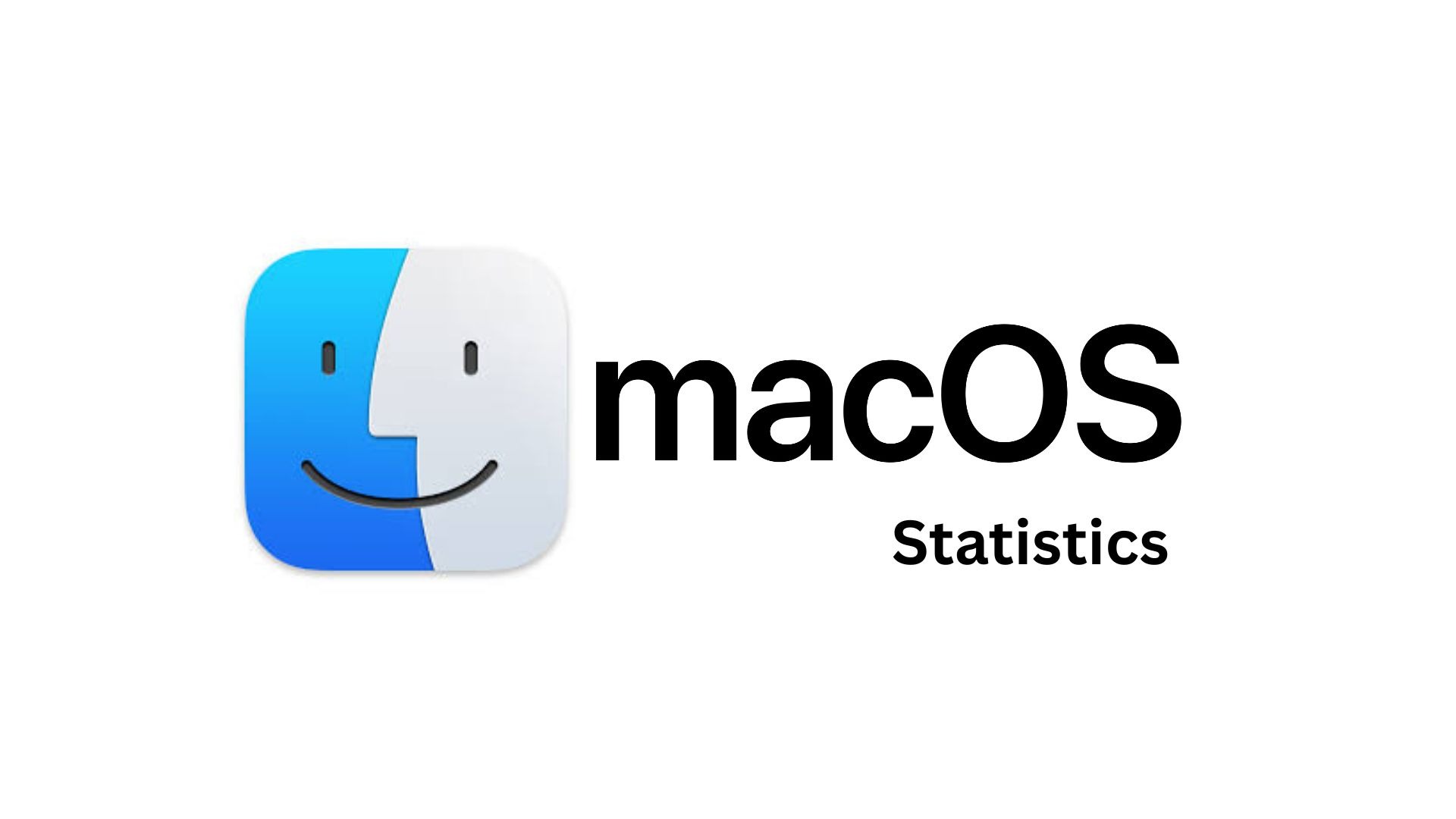
Table of Contents
Introduction
MacOS Statistics: macOS is Apple’s operating system for desktop computers, operating on Macs. In 2024, macOS cemented its presence in the global computing realm with solid growth rates across the user base, revenue generation, and geographical outreach.
The article is an overview of macOS statistics in 2024-how many people used it, how much revenue it generated, and its market shares in different regions, most popular versions, and its status against competing platforms like Windows and Linux.
Editor’s Choice
- In less than two months of release, macOS 15.5 crossed 70% adoption, making it a swiftly dominant version.
- Just before macOS 15.5 came in, macOS 15.4 shot up from below 5% to over 55%, to then fall back to 4.43%.
- In the Desktop/laptop OS Market of the United States, macOS stands at 29.62%, meaning almost 1 of every 3 users.
- Windows’ OS market share in the U.S. has been in a steady decline-from 92.37% in 2009 to 57.37%.
- Apple’s revenue for the Mac hit US$42.3 billion in 2024, fueled largely by demand for M2 and M3 chip MacBooks.
- 40.3% of Mac users worldwide are situated in the US, with Europe following at 30.2%, and Asia at 20.5%.
- Between the ages of 18–34, 55.7% of Mac users are students and young working professionals.
- 66% of Mac users are females, thus showing a strong preference among them.
- Still growing, Mac computers represent only 7.7% of total Apple sales in 2023, as against 86% in 2000.
- Among engineering professionals around the globe, macOS is the primary platform chosen by 87% of them and 44% software developers.
- MacBook Air continues to be the top-selling Mac, followed by MacBook Pro and then iMac among the community of professionals and creatives.
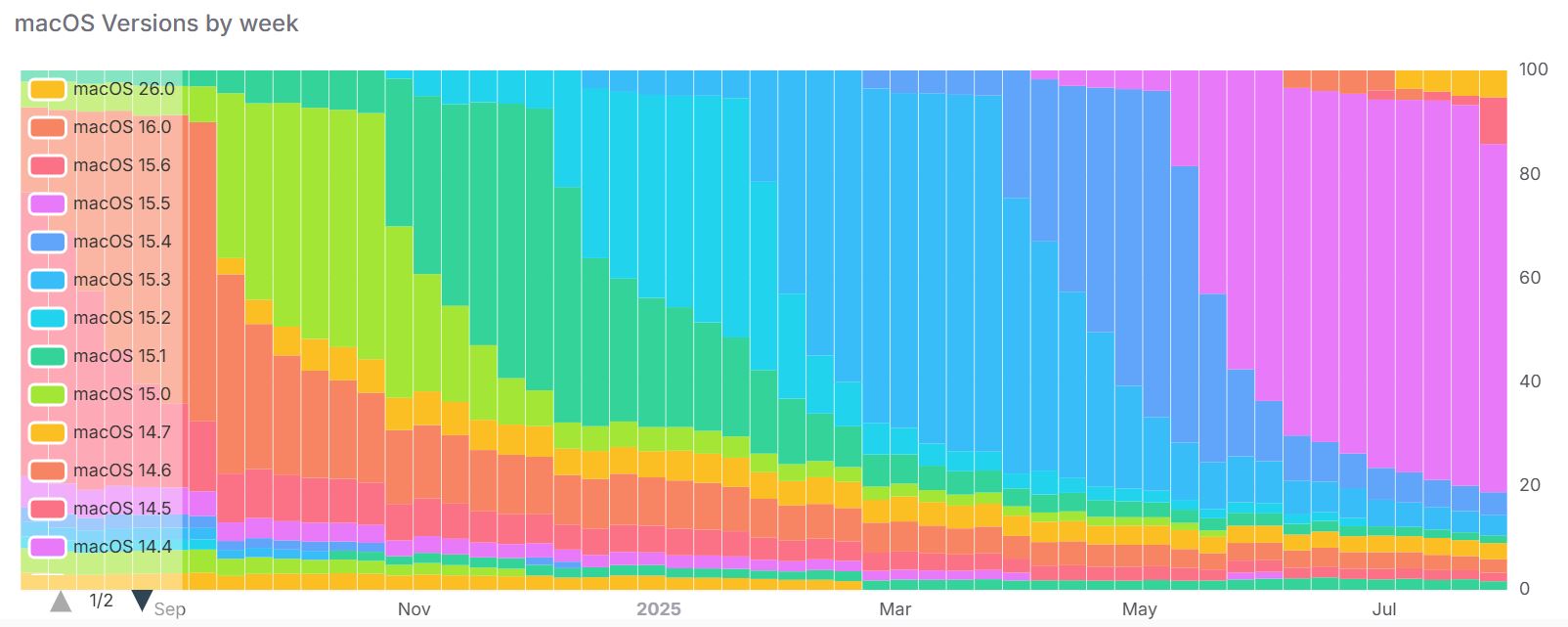
(Source: telemetrydeck.com)
- As per Telemetrydeck, macOS statistics show how different macOS versions gained or lost their popularity in each week over the past year, with the percentage share of active users in focus.
- One important takeaway was how quickly macOS 15.5 took hold.
- It had just entered the charts at about 3.6% at the very end of April 2025, but then zoomed up to more than 70% by the end of June.
- At the end of July, it still maintained a very high share of approximately 67.05%, illustrating that it quickly became the dominant version.
- Another noticeable trend has been with macOS 15.4.
- In a very short time-or just about five weeks-between mid-March and the end of April, its share jumped sharply from below 5% to above 55%.
- By the end of July, the share had plummeted to as few as 4.43%.
- MacOS 15.4 was adopted early and widely but was soon eschewed in favour of 15.5, once the latter had been more broadly rolled out.
- There remains the newly emerging version of macOS 26.0 in the data.
- It has already gained a 5.17% share by the end of July 2025, even though it seemingly made its first appearance only late in the cluster’s first timeframe.
- This hints at a reflector surface as to a gradual roll-out of a much newer generation of macOS, which might gain further accentuation in the upcoming months.
- In totality, the chart can be seen to show how fast macOS-land moves whenever it sees any new version out.
MacOS Version Adoption Statistics
- Without further ado, here is a timeline of macOS install base development for the period from late 2024 to late March 2025.
- Each new major-release update wave immediately affects the evolution of the adoption curve of the current version.
- By the end of November 2024, macOS 15.1 was the most widely deployed by more than half of all installations. Shortly thereafter, the window of opportunity became narrow.
- By the end of January 2025, macOS 15.2 had taken over the lead, clocking over 35% share.
- Yet, by the end of March, 15.1 and 15.2, both of which had engineers’ hearts beating, became almost unheard of with less than 4% user base, a stark testimony to how rapidly users get on the latest wave.
- Later, by the end of March 2025, macOS 15.3 was declared king of the macOS world, making a potent splash of 66.82% in usage.
- The majority of its growth happened very quickly-with a rise of more than 40% during February alone.
- For the whole month of March, overall usage of macOS 15.3 remained unchanged, while there was a massive pivot toward a single sub-version.
- 15.3.2 security update was swiftly adopted and comprised over 84% of all 15.3 installs by the end of March, which means users didn’t just upgrade to major versions but were keen on keeping up with minor patches too.
- In that very timeframe, macOS 15.4 started gaining traction.
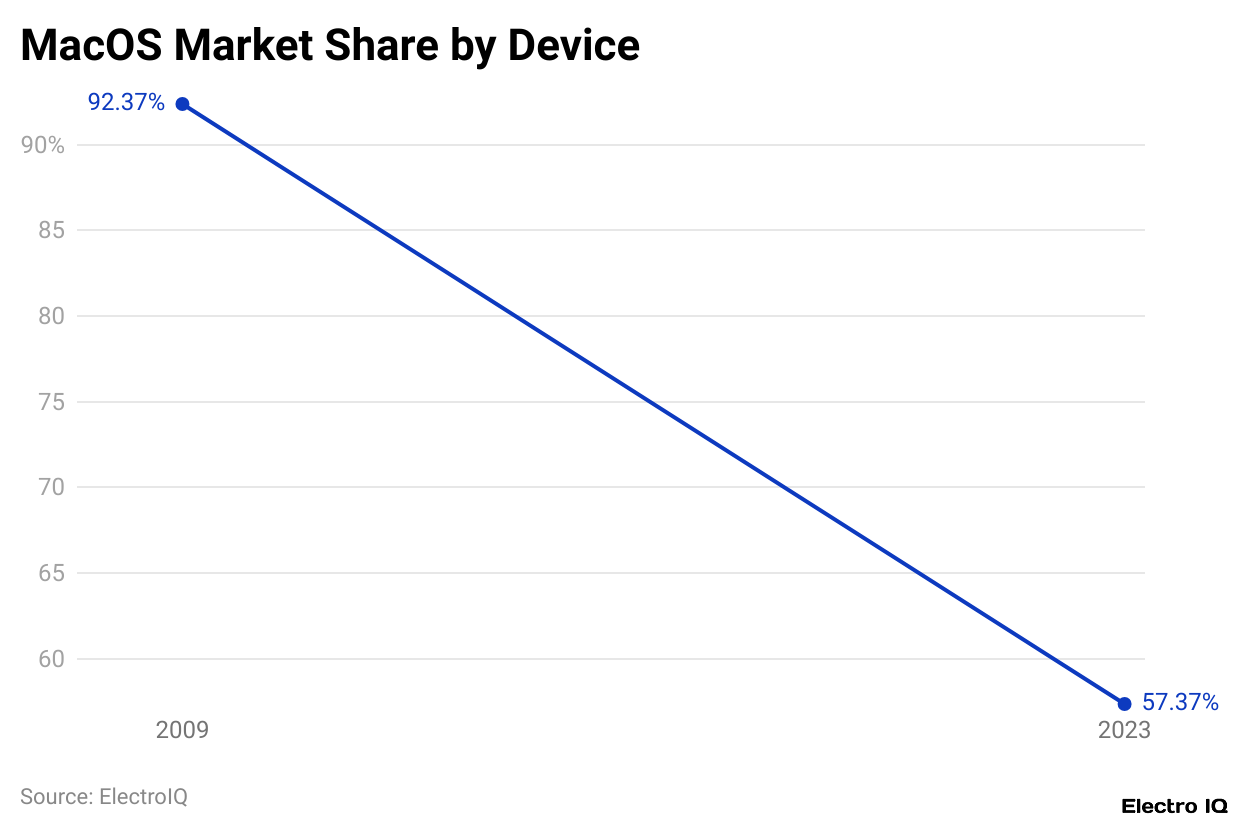
(Reference: techjury.net)
- The desktop and laptop OS market is traditionally dominated by Windows because of the multiple manufacturers that support it, such as Dell, HP, and Lenovo.
- But recent figures state that, in the US, Windows is slowly losing ground to other systems, chiefly macOS and, to a slightly lesser degree, ChromeOS.
- Despite many obstacles, MacBooks continued to be the main player.
- One of the biggest reasons is that macOS currently holds a 29.62% share of the desktop and laptop operating system market in the US, according to Serpwatch.
- A huge reason for Windows’ decline is the boost in popularity of both macOS and ChromeOS. Back in January 2009, Windows had around a 92.37% share of the US desktop OS market.
- But that number nowadays stands at a feel-good 57.37%.
- This downward slope is promising to keep going at least throughout 2023, as more users are shifting away from Windows to other systems, with macOS getting the major cuts.
Apple Mac Revenue
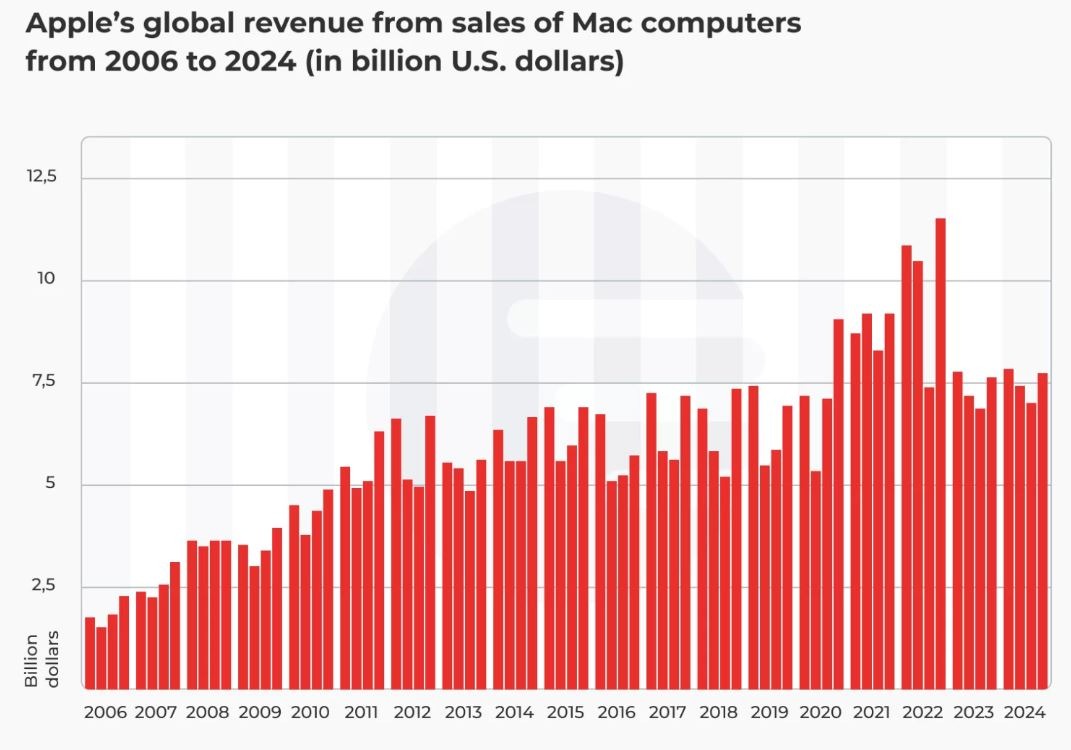
(Reference: mac.eltima.com)
- As per Mac. eltima, macOS statistics state that Mac computers mark a fair and considerable stream of revenue for Apple.
- The MacBooks and iMacs alone grossed about US$42.3 billion worldwide in 2024, proving the continued importance of Mac sales in Apple’s big picture.
- Success in Mac sales also hinges on the broad assortment of Mac products from Apple.
- The newer M2 and M3 powered MacBooks attracted a wider gamut of users, including the average Joe and professionals who need high-performance machines for their work or design or coding.
- These chipsets bring to the table great speed, phenomenal battery life, and superb energy efficiency-a serious contender for the everyday man.
- A strategic thinking of Apple contributes to revenue generation for the Mac.
- Apple constantly pushes the engineering envelope and builds performance into the design of the product, along with sustainability and top-quality design.
MacOs Demographics
By Region
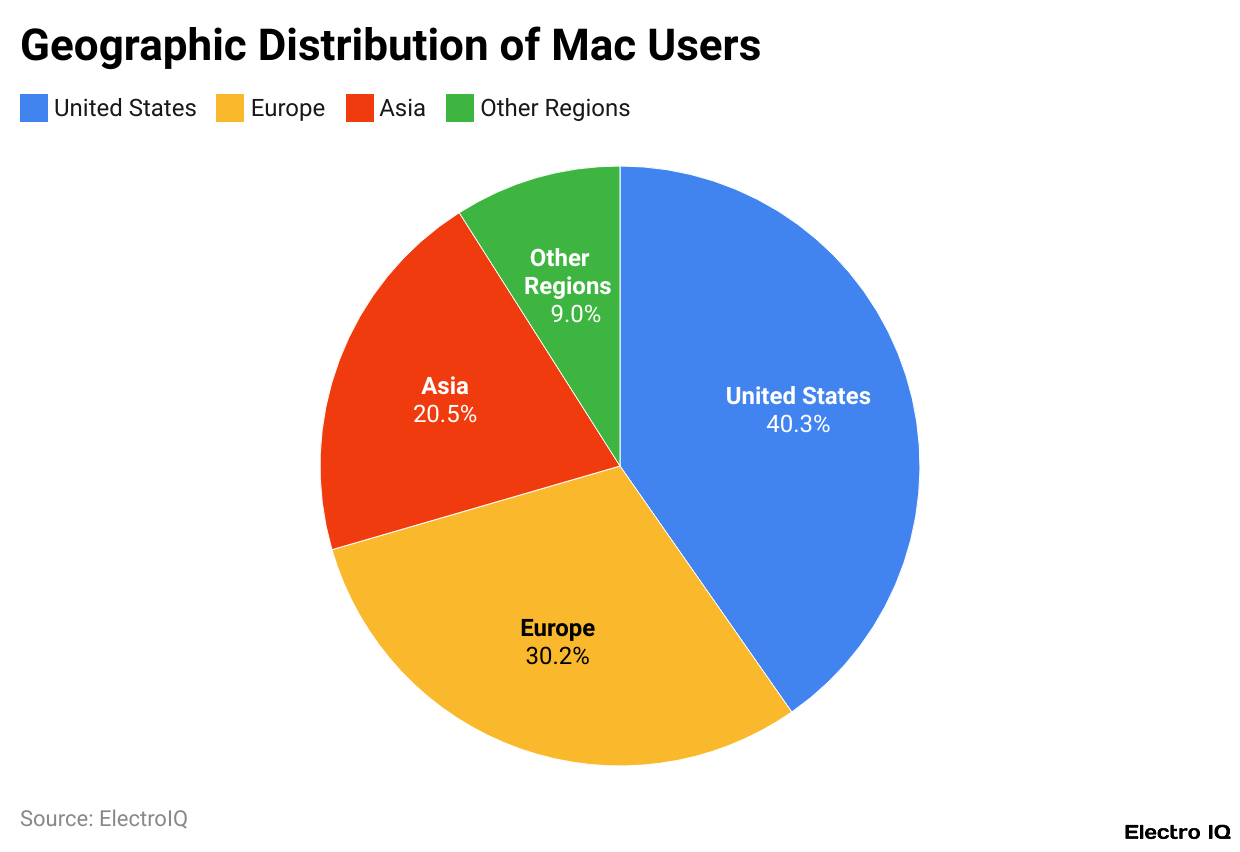
(Reference: spyhunter.com)
- This Mac user base is geographically scattered across multiple regions worldwide, with usage patterns differing widely from locality to locality.
- The United States is the biggest market for macOS devices, with second second-highest number of macOS users, accounting for approximately 40.3% of total macOS users.
- Europe accounts for 30.2% of Mac users. The United Kingdom, Germany, and France stood out as the major markets for sufficiently adopting Apple computers.
- Asia houses 20.5% of all Mac users. That growth is attributed mainly to Japan and China, with more people in either of those countries switching to or adopting Mac devices.
- The remaining 9% of Mac users are scattered around the world, with Latin America, Africa, and Oceania having low but paying attention to usage.
- In brief, while the greatest Mac use occurs in the United States and Europe, steady growth is also seen in Asia, with small-but-meaningful adoption elsewhere.
By Age
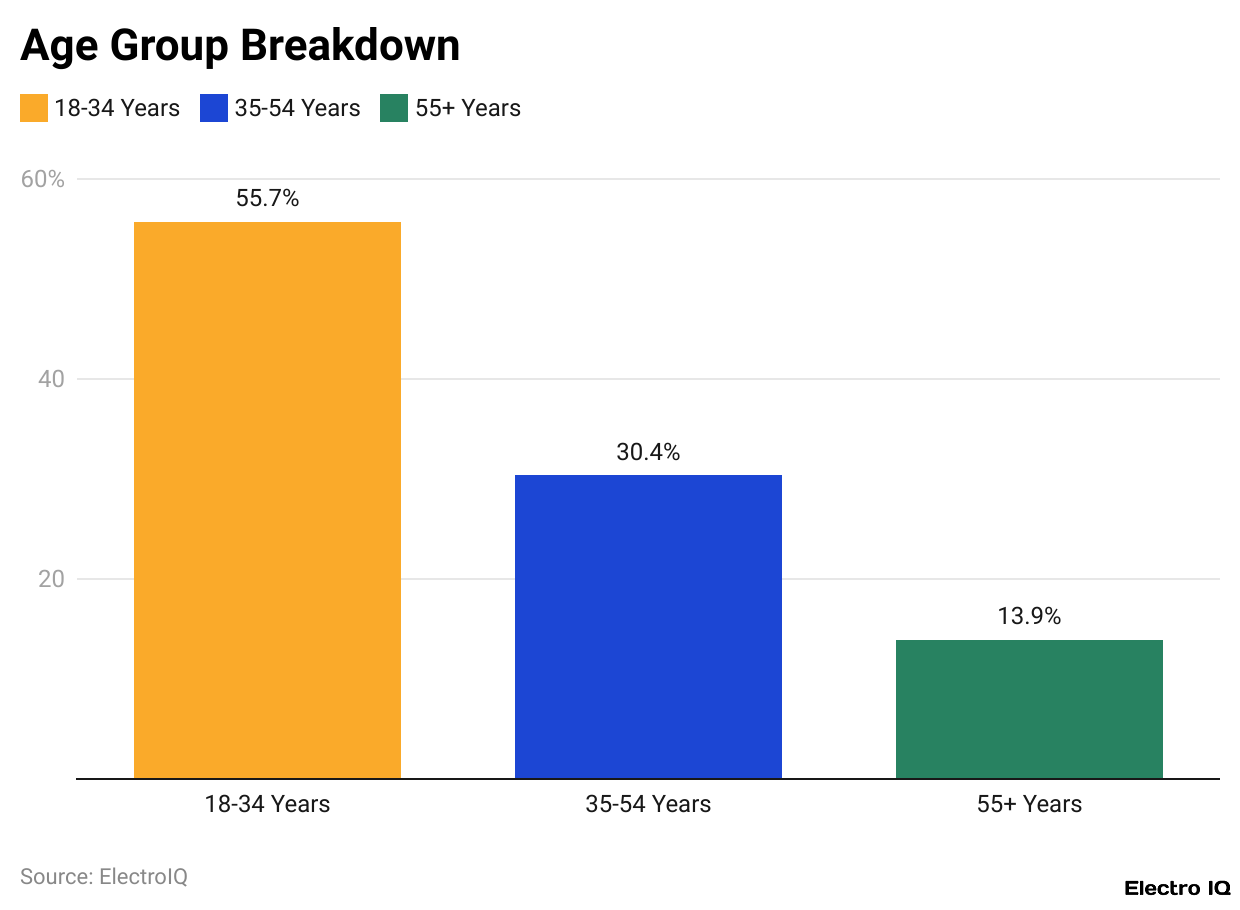
(Reference: spyhunter.com)
- About 55.7% of Mac users lie in the 18-34 age group. Mostly because that segment comprises college students, young professionals, and really artsy folks who are into Macs.
- Another 30.4% of Mac users lie in the 35-54 age group; this group usually uses Macs for whatever professional or business applications stand to benefit them.
- The last 13.9% are a share of users who are 55 or older.
- While this older segment is smaller in size, it still accounts for that loyal group of longtime Mac users who love the brand for its reliability and ease of use.
By Gender
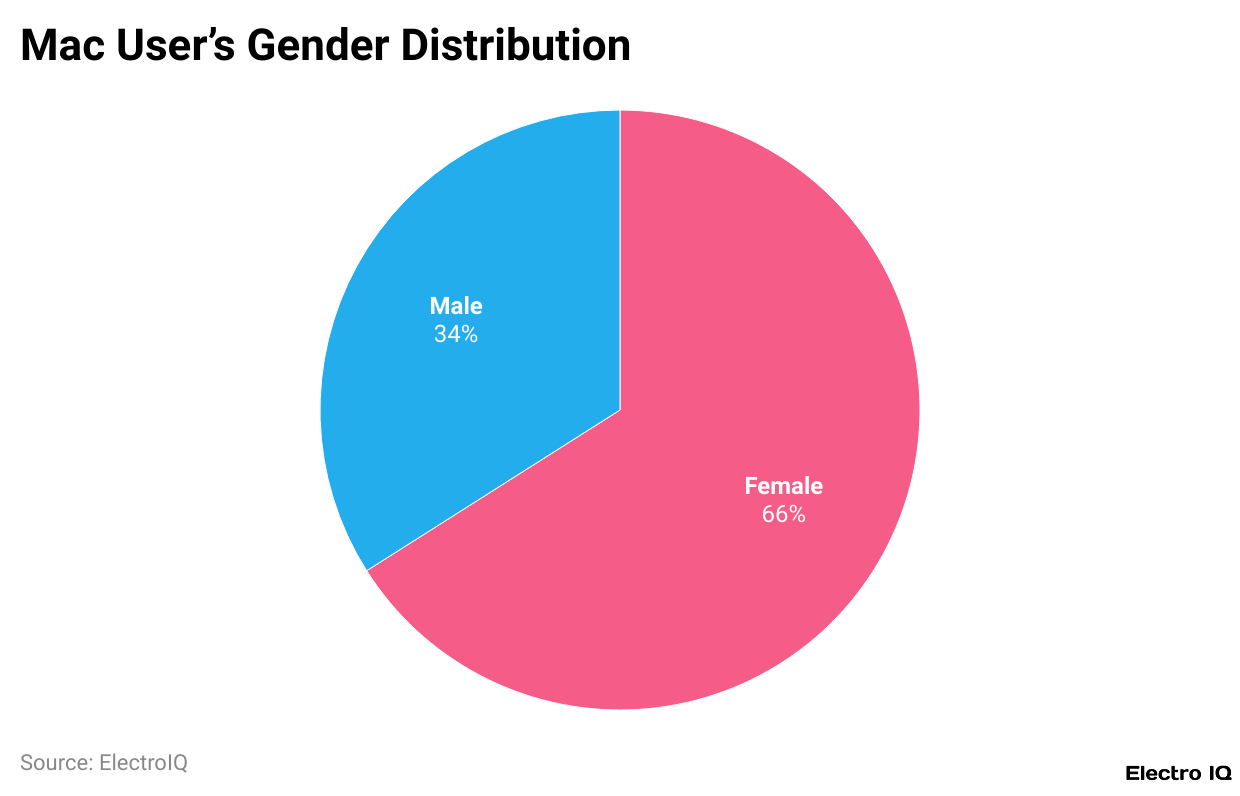
(Reference: spyhunter.com)
- There is a clear divergence in preference for Macs by sex.
- Only about 34% of Mac users are male, whereas 66% are female.
- Two out of three Mac users being women clearly shows the attractiveness Macs have from the female point of view—perhaps due to design, usability, brand perception, and reliability.
Sales Of Apple Mac
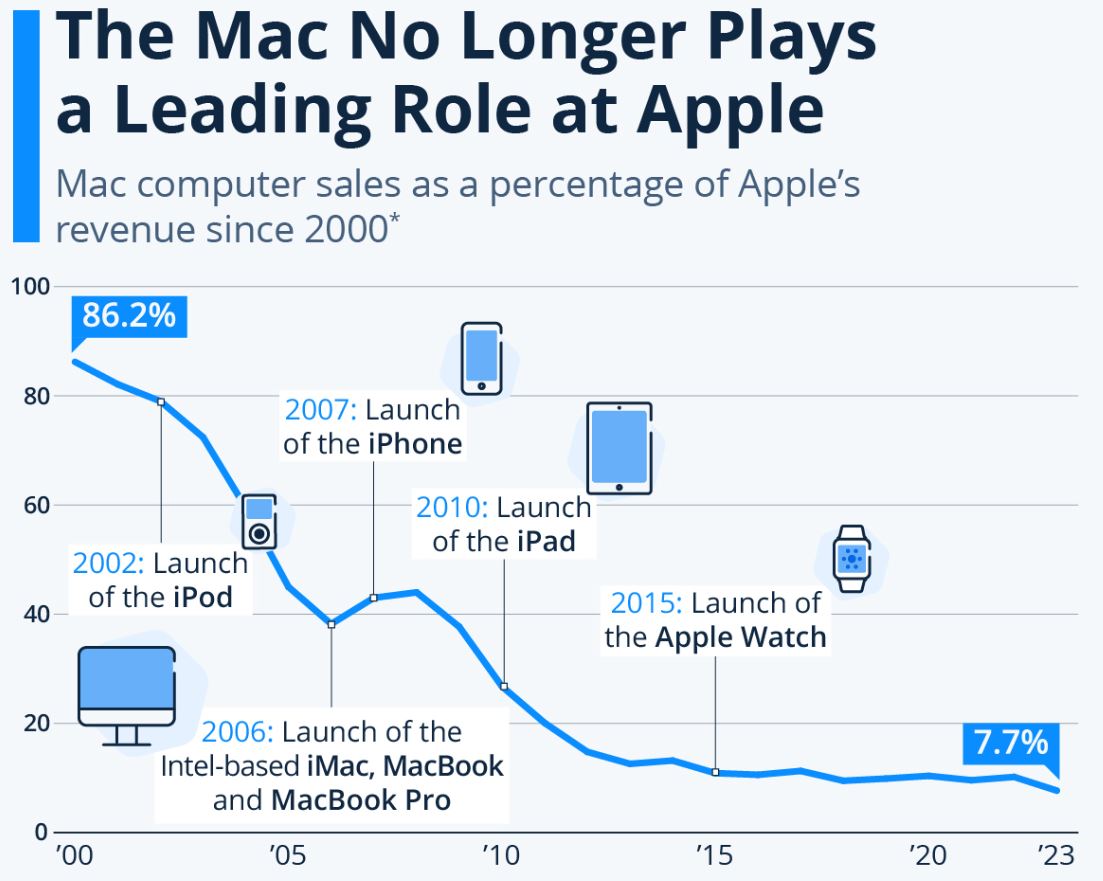
(Source: statista.com)
- On January 24, 1984, Apple introduced the Macintosh, and it was revolutionary because it was the first mainstream computer with a graphical interface and a mouse.
- While it became the platform for Apple’s early successes, it now forms the historical backbone of the company, but it does not generate significant revenue for the company.
- For Apple’s fiscal year ending September 30, 2023, Apple made US$29.4 billion from computer sales. That number alone is more than four times what Apple made from Mac sales circa the year 2000.
- At any rate, the computer segment does not really run Apple as it used to.
- Over roughly the same period, Apple’s total revenues grew close to 50 times in magnitude-meaning that Mac revenues simply could not keep pace with the explosive growth in other cardinal areas of Apple.
- The release of the inaugural iMac in 1998 signified Steve Jobs’ return to the company and helped stabilise Apple.
- Stated plainly, the Mac platform served just as a launch pad for even bigger projects.
- The early 2000s saw further success with the introductions of the iPod, iPhone, and iPad; the focus evolved from the computer, and the role of the Mac in Apple’s revenue mix took a steep dive.
- It was back in 2000 that Mac sales accounted for some 86% of Apple’s revenues, with this figure dropping substantially by 2023 and standing at a record low of just 7.7%.
- The growth of Mac sales in absolute terms over the past 20 years has now become a considerably smaller piece of Apple’s overall business because of the burgeoning successes achieved by the company in other product categories.
MacOs Popularity
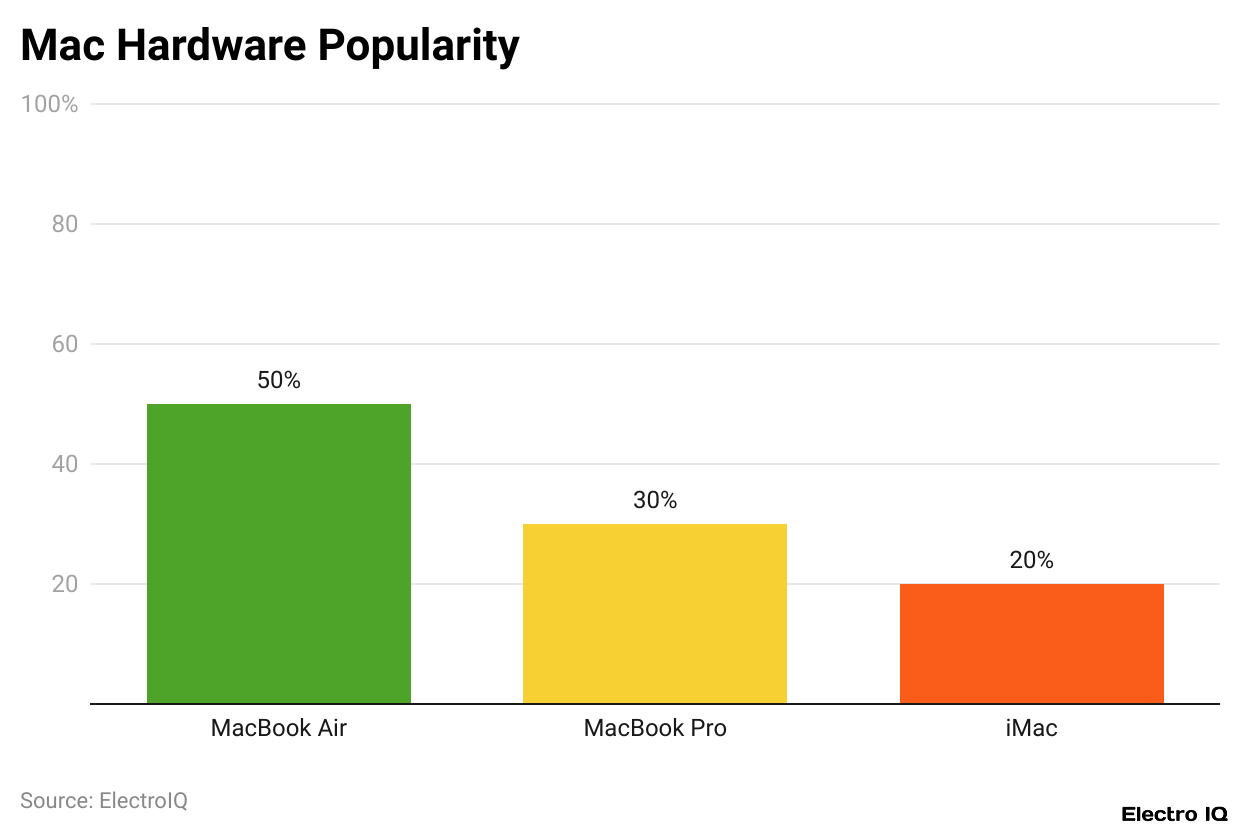
(Reference: spyhunter.com)
- As per Spyhunter, macOS statistics show that Macs have always been extremely popular in certain professional and industry sectors.
- Since the creative and technical fields are vast, there are areas where they remain the preferred option.
- Around 87% of engineering professionals rely on macOS because of its Unix-based system, providing stability and solid performance for technical work.
- Similarly, around 44% of software developers worldwide use macOS because it provides a powerful and reliable environment in which to code, develop apps, and do testing.
- They are also used extensively in the field of education, chiefly in the United States.
- The reason about 23% of educational institutions in the United States, especially among colleges and universities, have Mac computers is that they find them reliable, well-made, and great-performing in the long term.
- Once hardware preferences are made for the users who own a Mac, a particular variety of Mac may be more popular than others.
- Being lightweight and portable, and affordable compared to the other models, it is the most sought-after MacBook Air among students and everyday professionals.
- The MacBook Pro, conversely, is used by professionals for higher-end performance work such as video editing, programming, or design.
- The iMac is favored by arts professionals because of the all-in-one system with the large display and clean setup, thus facilitating visual work such as graphic design and video production.
Conclusion
MacOS statistics: Generally speaking, macOS continues to gain strength as a global desktop operating system market with rapidly emerging new versions, a strong user base in the United States, and increasing demand among professionals and students. Even though it commands a 5% share of the world market compared to Windows, macOS seems to be constantly gaining ground in the United States, continuing to bring heavy revenues to Apple, amounting to some US$42.3 billion in 2024.
In spite of Macs now accounting for a lower percentage of overall revenues compared to other Apple products, they still enjoy a steady kind of popularity due to their performance, stability, and user interface. macOS holds a significant and growing appeal both among demographic cohorts and within the professional world and thus remains indispensable to the Apple ecosystem.
FAQ.
After its release, macOS 15.5 almost immediately became the dominant version in 2025. It shot up from 3.6% usage at the end of April to over 70% by the close of June. By the end of July 2025,macOS 15.5 kept a strong 67% share, which points toward very fast adoption of this version across Mac devices by users.
In the USA, macOS holds roughly 29.62% market share for desktop and laptop operating systems, which means one in every three users. Windows has been on a steady decline as far as market share is concerned, plummeting from 92.37% of the desktop OS market in the USA in 2009 to 57.37% presently. macOS and ChromeOS have largely contributed to this decline.
Apple generated revenues of US$42.3 billion worldwide for MacBook and iMacs in 2024. While revenues from Macs have multiplied over the years, Macs have dwindled as an earning source for Apple-being just 7.7% of total company revenues in 2023 as opposed to 86% back in 2000.
Roughly 55.7% of the Mac user population ranges in age from 18 to 34, showing the brand’s popularity among students and young professionals. Geographically, most users (approximately 40.3%) come from the United States, with the rest being scattered, 30.2% in Europe, and 20.5% in Asia. Also, 66% of Mac users are females, while the rest are men, showing that the adoption is higher among women.
macOS is widely used in the technical and creative industries. In fact, about 87% of engineering professionals and 44% of software developers come nationwide to use macOS because of its Unix-based system, stability, and great development tools. It is also commonly applied in educational institutions within the U.S. (23%), particularly in higher education, when considered for its reliability and performance.

I’m Pawan Kumar, co-founder of Elbestor.com, and an SEO expert, blogger, and digital marketer with over 7 years of experience. Since 2018, I've been helping businesses grow their online presence by crafting strategies that boost search engine rankings, create engaging content, and drive meaningful traffic. I’m passionate about making the digital world a little more accessible for businesses, whether that’s through writing helpful blog posts or optimizing websites for better visibility.

